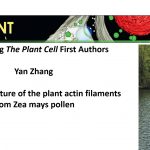Recognizing Plant Cell first authors: Zhanhong Ren
Zhanhong Ren, co-first author of Cryo-EM structure of the plant actin filaments from Zea mays pollen
Current Position: Ph.D. Candidate, Center for Biological Science and Technology, Key Laboratory of Cell Proliferation and Regulation Biology of Ministry of Education, College of Life Sciences, Beijing Normal University, China
Education: Ph.D. Candidate in Cell Biology, Beijing Normal University, China; M.Sc. in Bioengineering, Wuhan University, China; B.Sc. in Biotechnology, Yangtze University, China
Non-scientific Interests: Playing the erhu, playing basketball, swimming, hiking, and reading
Brief bio: Cryo-Electron Microscopy (Cryo-EM) is not a popular method for structural biologists until 2014. At that time, I started my Ph.D. study in the lab of Prof. Haiyun Ren, where I mainly focused on the structural determination of plant actin filaments. As a fact, there were not any related experimental devices and research experiences of Cryo-EM in the lab. At the beginning, I ran into difficulties. After a long time of learning and experience accumulation about the new method, I have overcome them and can operate the Cryo-EM equipment by myself. I collected a high-quality cryo-EM dataset of plant actin filaments in 2017. Finally, the first structure of plant actin filaments is revealed and its resolution (3.9 angstrom) is close to those in the other reported eukaryote and prokaryote filamentous structures. Besides, I learn and master other research techniques independently (e.g., total internal reflection fluorescent microscopy and single-molecular magnetic tweezers). I measured the rupture force of a single actin filament firstly by using the single-molecular magnetic tweezers. Our structural and biochemical data suggest that Zea mays pollen actin filament is more stable than rabbit skeleton muscle actin filament, which provides a possible explanation for their functional differences in cells. I have always been fascinated by the structural and single molecular research. After completing my Ph.D. study, I will continue to focus on the Cryo-EM and single molecular research.
论文:Cryo-EM structure of the plant actin filaments from Zea mays pollen
第一作者:任展宏
目前职位:博士研究生,北京师范大学生命科学学院细胞增殖及调控生物学教育部重点实验室生物科学技术中心
教育经历:北京师范大学细胞生物学博士研究生;武汉大学生物工程硕士研究生;长江大学生物技术本科。
兴趣爱好:拉二胡,篮球,游泳,徒步旅行,阅读
个人简介:冷冻电子显微镜(Cryo-EM)直到2014年之后才成为结构生物学家的热门方法。那时,我在任海云教授实验室刚开始博士研究生的工作,主要研究植物细胞微丝的结构。事实上,我们没有相关的冷冻电镜实验设备和研究经验,一开始,我遇到了困难。经过长期的学习和经验积累,我克服了这些困难,自己可以独立操作冷冻电镜。2017年,我收集了一套高质量的植物细胞微丝的冷冻电镜数据。最终,第一个植物细胞微丝的结构得到了解析,其分辨率(3.9埃)接近于其他已经报道的真核和原核细胞微丝结构。此外,我还独立学习和掌握了其他研究技术(如全内反射荧光显微镜和单分子磁镊)。我使用单分子磁镊技术首次测量了单根微丝的断裂力。我们的结构和生化数据表明,玉米花粉微丝比兔骨骼肌微丝更加稳定,为它们在细胞中的功能差异提供了一种可能的解释。我一直对结构和单分子研究很感兴趣。完成博士研究之后,我将继续专注于冷冻电镜和单分子研究。




